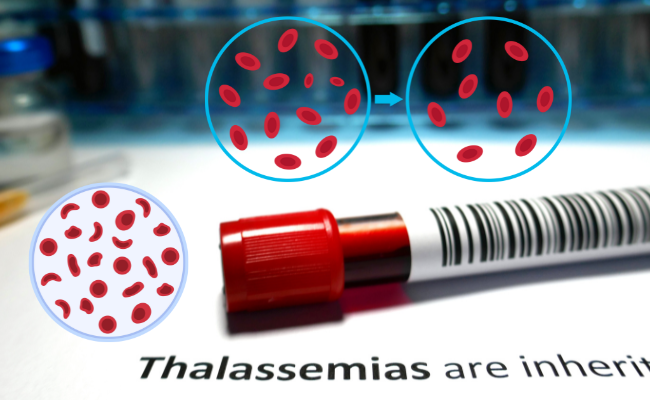How to Treat Thalassemia?
- November 11, 2023
- No Comments

What is Thalassemia?
Thalassemia is a genetic blood disorder characterized by abnormal hemoglobin production, leading to inadequate red blood cell formation. Hemoglobin is a protein in red blood cells that carries oxygen to various parts of the body. Individuals with thalassemia produce fewer healthy red blood cells and less hemoglobin than normal, resulting in anemia and potential complications.
Why is Thalassemia a Concern?
Thalassemia poses a significant health concern due to its impact on the oxygen-carrying capacity of the blood. Without sufficient oxygen, vital organs and tissues may not function optimally, leading to fatigue, weakness, and other complications. Additionally, severe forms of thalassemia can cause issues such as bone deformities, enlarged spleen, and growth delays in affected individuals.
How is Thalassemia Inherited?
Thalassemia is primarily an inherited disorder, passed down from parents to their children through genetic mutations. The condition arises when there are abnormalities in the genes responsible for producing hemoglobin. Individuals with one affected gene are carriers (thalassemia trait), while those with two affected genes (one from each parent) may experience the symptoms of thalassemia.
Treatment Solutions for Thalassemia:
While thalassemia cannot be completely cured, various treatment approaches aim to manage symptoms and improve the quality of life for affected individuals.
Blood Transfusions
Regular blood transfusions are a common and crucial component of thalassemia treatment. These transfusions provide the patient with healthy red blood cells, compensating for the reduced production of normal cells. The frequency of transfusions depends on the severity of the thalassemia.
Chelation Therapy
Blood transfusions, while essential, can lead to an accumulation of iron in the body. Excess iron can cause damage to organs such as the heart and liver. Chelation therapy involves the use of medications that bind to excess iron, facilitating its removal from the body. This helps prevent iron overload-related complications.
Stem Cell Transplantation
For some individuals, especially those with severe thalassemia, a stem cell or bone marrow transplant may be a viable option. This procedure involves replacing the patient's bone marrow, which is responsible for producing blood cells, with that of a compatible donor. Stem cell transplantation can potentially cure thalassemia, but finding a suitable donor and managing potential complications make it a complex and challenging treatment option.
Gene Therapy
Advancements in medical science have paved the way for gene therapy as a potential treatment for thalassemia. This experimental approach involves modifying the patient's own cells to correct the genetic mutations responsible for thalassemia. While still in the early stages of research, gene therapy holds promise as a potential cure for thalassemia in the future.
Benefits of Thalassemia Treatment:
- Improved Quality of Life: The primary goal of thalassemia treatment is to enhance the overall well-being of affected individuals. By addressing anemia and associated complications, treatment helps improve energy levels, reduce fatigue, and enhance daily functioning.
- Prevention of Complications: Regular blood transfusions and chelation therapy play a crucial role in preventing complications associated with thalassemia, such as organ damage due to iron overload. Timely and consistent treatment can significantly reduce the risk of long-term health issues.
- Increased Life Expectancy: Advances in thalassemia treatment have significantly increased life expectancy for individuals with the condition. With proper management, many individuals with thalassemia can lead fulfilling and productive lives.
- Potential for Cure: Stem cell transplantation and gene therapy offer the potential for a cure in certain cases of thalassemia. While these approaches are not without challenges, they represent promising avenues for a future where thalassemia can be eradicated at its genetic roots.
Comments (0)